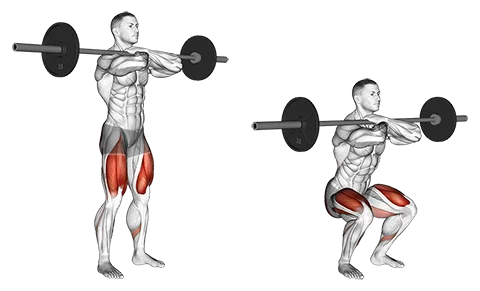Introduction
The Barbell Front Squat is a weightlifting exercise that targets the quadriceps, glutes, hamstrings, and core muscles. It primarily strengthens lower body and improves mobility by requiring you to squat while holding a barbell in front of your shoulders. This exercise is effective for various fitness goals, particularly developing functional strength and improving athletic performance due to its emphasis on explosive power and balance.
Muscles Worked
- Primary: Quadriceps, Gluteus Maximus, Hamstrings, Calves, Core (Abdominals)
- Secondary: Erector Spinae, Soleus, Gastrocnemius, Tibilis Anterior, Adductors, Obliques, Rectus Abdominis
How to Do It (Step-by-Step)
- Stand with feet shoulder-width apart, toes pointed slightly outwards, holding a barbell across the front of your shoulders with an upright torso and elbows up. The bar should be supported by your shoulders (the front racks position).
- Lower the barbell while bending at the knees and hips, keeping the weight on your heels until the thighs are parallel to the floor. Then ascend back to the starting position.
- Keep the head neutral, core engaged, knees aligned with toes, chest up, and back straight throughout the movement. Avoid leaning forward or rounding the back.
- Tip: Maintain control throughout the entire range of motion and focus on squatting down as if sitting into an imaginary chair to ensure proper depth and form.
Rep & Rest Guidelines
- Strength: 4–6 reps, 2–3 min rest
- Hypertrophy: 8–12 reps, 60–90 sec rest
- Endurance: 12–20 reps, 30–60 sec rest
Auto Progression can help you track and adjust your weight over time.
Set a Rest Timer to ensure optimal recovery between sets.
Form Tips
- Maintain an upright torso and avoid rounding forward at the lower back. This helps to keep the spine in a neutral position and reduces strain on the lower back.
- Position the barbell on the front of your shoulders, with elbows up, creating a shelf for the barbell. This ensures proper loading on the muscles worked by the exercise, including quadriceps, glutes, and core.
- Squat down by pushing your hips backward rather than bending at the knees first. Keep feet shoulder-width apart and point toes slightly outward for better stability. Throughout the squat, keep weight distributed evenly between heels and balls of feet.
When to Use It
- Improving Quadriceps Strength: Barbell front squats are effective for targeting the quadriceps and developing lower body strength.
- Enhancing Functional Fitness: This exercise simulates real-world movements like picking up heavy objects, making it useful for improving functional fitness.
- Boosting Vertical Jump Power: Barbell front squats can help athletes increase their vertical jump height due to the emphasis on quadriceps and core muscles.
- Keep track of your progress with Workout History!
Barbell front squats strengthen the quadriceps, build core stability, and improve overall athletic performance.
Front squats place more emphasis on the quads and core due to the position of the barbell in front of the body.
Start with a weight that allows you to maintain proper form, ideally using a challenging but manageable weight.
A typical set/rep scheme for beginners is 3-4 sets of 8-12 reps, adjusting as necessary based on progression.
Avoid letting the elbows drop or bending too far forward, and ensure proper depth by lowering until hips are below knee level.

